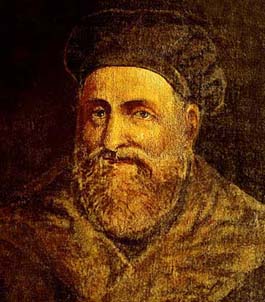<Back to Index>
- Physician Gabriele Falloppio, 1523
- Composer Bedřich Diviš Weber, 1766
- King of Portugal and the Algarve Dinis, 1261
PAGE SPONSOR

Gabriele Falloppio (1523 – October 9, 1562), often known by his Latin name Fallopius, was one of the most important anatomists and physicians of the sixteenth century.
He was born at Modena and died at Padua. His family was noble but very poor and it was only by a hard struggle he succeeded in obtaining an education. Financial difficulties led him to join the clergy, and in 1542, he became a canon at Modena's cathedral. He studied medicine at the University of Ferrara, at that time one of the best medical schools in Europe. He received his MD in 1548 under the guidance of Antonio Musa Brassavola. After taking his degree he worked at various medical schools and then became professor of anatomy at Ferrara, in 1548. Girolamo Fabrici was one of his famous students. He was called the next year to the University of Pisa, then the most important university in Italy. In 1551 Falloppio was invited by Cosimo I, Grand Duke of Tuscany, to occupy the chair of anatomy and surgery at the University of Padua. He also held the professorship of botany and was superintendent of the botanical gardens. Though he died when less than forty, he had made his mark on anatomy for all time.
This was the golden age of anatomy and Falloppio's contemporaries included such great anatomists as Vesalius, Eustachius, and Realdo Colombo (whom he succeeded at Padua). It has sometimes been asserted that he was jealous of certain of the great discoverers in anatomy and that this is the reason for his frequent criticisms and corrections of their work. However, Heinrich Haeser, an authority in the history of medicine, declared that Falloppio was noted for his modesty and deference to his fellow workers and especially to Vesalius. His purpose in suggesting corrections, therefore, was the advance of the science of anatomy.
Falloppio's own work dealt mainly with the anatomy of the head. He added much to what was known before about the internal ear and described in detail the tympanum and its relations to the osseous ring in which it is situated. He also described minutely the circular and oval windows (fenestræ) and their communication with the vestibule and cochlea. He was the first to point out the connection between the mastoid cells and the middle ear. His description of the lacrimal ducts in the eye was a marked advance on those of his predecessors and he also gave a detailed account of the ethmoid bone and its cells in the nose. His contributions to the anatomy of the bones and muscles were very valuable. It was in myology particularly that he corrected Vesalius. He studied the reproductive organs in both sexes, and described the Fallopian tube, which leads from the ovary to the uterus and now bears his name. The aquæductus Fallopii, the canal through which the facial nerve passes after leaving the auditory nerve, is also named after him.
His contributions to practical medicine were also important. He was the first to use an aural speculum for the diagnosis and treatment of diseases of the ear, and his writings on surgical subjects are still of interest. He published two treatises on ulcers and tumors, a treatise on surgery, and a commentary on Hippocrates's book on wounds of the head. In his own time he was regarded as somewhat of an authority in the field of sexuality. His treatise on syphilis advocated the use of condoms, and he initiated what may have been the first clinical trial of the device. Falloppio was also interested in every form of therapeutics. He wrote a treatise on baths and thermal waters, another on simple purgatives, and a third on the composition of drugs. None of these works, except his Anatomy (Venice, 1561), were published during his lifetime. As we have them, they consist of manuscripts of his lectures and notes of his students. They were published by Volcher Coiter (Nuremberg, 1575).